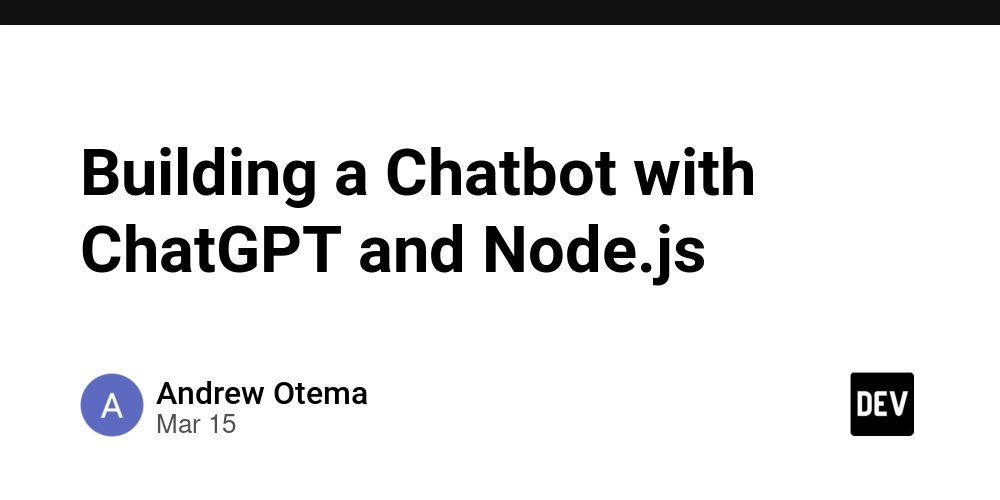Building a Chatbot with ChatGPT and Node.js
Introduction Chatbots are revolutionizing the way businesses interact with customers. With OpenAI's ChatGPT API, you can build a powerful chatbot that understands natural language and provides intelligent responses. In this tutorial, we’ll walk through how to create a chatbot using Node.js and the ChatGPT API. Step 1: Set Up Your Node.js Project Initialize a Node.js project: bash Copy mkdir chatbot cd chatbot npm init -y Install dependencies: bash Copy npm install express openai dotenv Create a .env file: Add your OpenAI API key: Copy OPENAI_API_KEY=your_openai_api_key Step 2: Create the Chatbot Backend Create index.js: javascript Copy const express = require('express'); const { OpenAI } = require('openai'); require('dotenv').config(); const app = express(); app.use(express.json()); const openai = new OpenAI({ apiKey: process.env.OPENAI_API_KEY, }); app.post('/chat', async (req, res) => { const { message } = req.body; try { const response = await openai.chat.completions.create({ model: 'gpt-3.5-turbo', messages: [{ role: 'user', content: message }], }); res.json({ reply: response.choices[0].message.content }); } catch (error) { res.status(500).json({ error: 'Something went wrong' }); } }); const PORT = process.env.PORT || 3000; app.listen(PORT, () => console.log(Server running on port ${PORT})); Run the server: bash Copy node index.js Step 3: Test the Chatbot Use tools like Postman or curl to send a POST request to http://localhost:3000/chat with the following JSON body: json Copy { "message": "Hello, how are you?" } Conclusion You’ve just built a chatbot using ChatGPT and Node.js! You can extend this by adding a frontend or integrating it into your existing applications. The possibilities are endless!

Introduction
Chatbots are revolutionizing the way businesses interact with customers. With OpenAI's ChatGPT API, you can build a powerful chatbot that understands natural language and provides intelligent responses. In this tutorial, we’ll walk through how to create a chatbot using Node.js and the ChatGPT API.
Step 1: Set Up Your Node.js Project
Initialize a Node.js project:
bash
Copy
mkdir chatbot
cd chatbot
npm init -y
Install dependencies:
bash
Copy
npm install express openai dotenv
Create a .env file:
Add your OpenAI API key:
Copy
OPENAI_API_KEY=your_openai_api_key
Step 2: Create the Chatbot Backend
Create index.js:
javascript
Copy
const express = require('express');
const { OpenAI } = require('openai');
require('dotenv').config();
const app = express();
app.use(express.json());
const openai = new OpenAI({
apiKey: process.env.OPENAI_API_KEY,
});
app.post('/chat', async (req, res) => {
const { message } = req.body;
try {
const response = await openai.chat.completions.create({
model: 'gpt-3.5-turbo',
messages: [{ role: 'user', content: message }],
});
res.json({ reply: response.choices[0].message.content });
} catch (error) {
res.status(500).json({ error: 'Something went wrong' });
}
});
const PORT = process.env.PORT || 3000;
app.listen(PORT, () => console.log(Server running on port ${PORT}));
Run the server:
bash
Copy
node index.js
Step 3: Test the Chatbot
Use tools like Postman or curl to send a POST request to http://localhost:3000/chat with the following JSON body:
json
Copy
{
"message": "Hello, how are you?"
}
Conclusion
You’ve just built a chatbot using ChatGPT and Node.js! You can extend this by adding a frontend or integrating it into your existing applications. The possibilities are endless!










































































































































































![[The AI Show Episode 142]: ChatGPT’s New Image Generator, Studio Ghibli Craze and Backlash, Gemini 2.5, OpenAI Academy, 4o Updates, Vibe Marketing & xAI Acquires X](https://www.marketingaiinstitute.com/hubfs/ep%20142%20cover.png)



























































































































![[FREE EBOOKS] The Kubernetes Bible, The Ultimate Linux Shell Scripting Guide & Four More Best Selling Titles](https://www.javacodegeeks.com/wp-content/uploads/2012/12/jcg-logo.jpg)



![From drop-out to software architect with Jason Lengstorf [Podcast #167]](https://cdn.hashnode.com/res/hashnode/image/upload/v1743796461357/f3d19cd7-e6f5-4d7c-8bfc-eb974bc8da68.png?#)






































































































.png?#)




.jpg?#)































_Christophe_Coat_Alamy.jpg?#)








































































































![Rapidus in Talks With Apple as It Accelerates Toward 2nm Chip Production [Report]](https://www.iclarified.com/images/news/96937/96937/96937-640.jpg)









































































































































